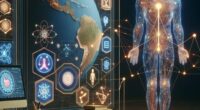Nature’s Blueprint: Unlocking Complex Solutions Through AI
In the quest for technological advancement, nature has frequently served as a source of inspiration. Among the most captivating fields to emerge from this intersection of natural wonder and computational prowess are nature-inspired algorithms. These intricate computer programs are modeled after the ingenious methods through which flora, fauna, and even physical phenomena tackle challenges, thereby offering a novel lens through which to view and solve human problems.
In essence, nature-inspired algorithms are digital manifestations of the robust, adaptive strategies found within natural and social systems. By observing and distilling the essence of how creatures like ants, bees, bats, and birds navigate their worlds, scientists and engineers have crafted algorithms that mirror these behaviors. The classifications of these algorithms are as diverse as the natural behaviors they emulate, ranging from the collective decision-making processes observed in swarms to the evolutionary adaptations seen in biological entities, and even encompassing the principles guiding physical and chemical changes.
One of the standout categories within nature-inspired algorithms is swarm intelligence. It’s a concept borrowed from the natural world, where the collective intelligence of groups—be it schools of fish navigating treacherous waters or flocks of birds synchronizing their flights—leads to remarkably efficient problem-solving. This principle of self-optimization, wherein a system naturally adjusts to optimize resources and adapt to environmental shifts, is at the heart of what makes swarm-based algorithms so potent and promising for tackling contemporary challenges.
A compelling example is detailed in research highlighted in the International Journal of Advanced Intelligence Paradigms. Researchers S. Thanga Revathi and N. Ramaraj discuss the potential of nature-inspired algorithms to address complex issues that might otherwise seem insurmountable. Among the algorithms they investigate are ant colony optimization (ACO), particle swarm optimization (PSO), cuckoo search, and the bat algorithm. Each of these draws on specific aspects of collective natural behaviors to find solutions, illustrating the versatile capability of such algorithms to decipher problems.
Take, for instance, the phenomenon of bird flocking. Individual birds adhere to simple rules, such as avoiding collisions and maintaining proximity, without explicit leadership. These rules result in the complex and awe-inspiring formations known as murmurations. Beyond their beauty, these natural spectacles embody a collective strategy for predator evasion, demonstrating how uncomplicated rules can give rise to sophisticated group dynamics.
Going beyond mere fascination, the practical implications of algorithms inspired by swarm behaviors are vast and varied. In the realm of biomedicine, they’ve facilitated advancements in diagnostics, genetic research, and the modeling of protein structures. Beyond healthcare, these algorithms are optimizing network management, enhancing data classification techniques, and improving queuing systems across numerous industries.
The burgeoning field of nature-inspired algorithms suggests we are on the cusp of a new era in computational problem-solving. As Thanga Revathi and Ramaraj articulate, the potential applications for these systems are as vast as the natural world itself. With each algorithm developed, we unlock a further understanding not only of the complexities inherent in our own problems but also of the elegant simplicity offered by nature’s solutions.
This blending of natural wisdom with artificial intelligence represents a promising frontier in our ability to confront and overcome the multifaceted challenges of the modern world. As we continue to explore and model the myriad systems observed in nature, the potential for innovative solutions grows, offering hope for a future where technology and nature coalesce to address humanity’s most pressing problems.










